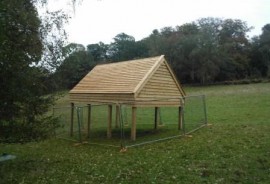Bat surveys were required prior to an extensive redevelopment of the former Brunel University Runnymede Campus in Middlesex.
The approved scheme would provide approximately 43,384m2 accommodation for students and ancillary accommodation, 59 extra care units, 28 affordable housing units, 76 private residential units as well as car parking, landscaping and local infrastructure.
The problem
The extensive plans included the demolition of buildings and the construction of new-build. Initial scoping surveys indicated a high likelihood that bats used the area. Our further surveys found common pipistrelles, soprano pipistrelles, serotines, brown long-eared bats and Natterer’s bats, all roosting within buildings! We also found two maternity colonies.
The solution
In order to obtain a European Protected Species Mitigation (EPSM) licence from Natural England to allow the planned works to proceed, our bat ecologists designed extensive mitigation measures and agreed with the developer a phased approach to the works. Some roosts were preserved, whilst where this was not possible suitable replacement roosts were built into the retained buildings and in the new construction. The maternity colonies were retained in situ and protected during the works.
A bat hibernaculum was also designed, which involved leaving an area of a basement closed off and undisturbed to ensure that conditions were cold and at a constant temperature and humidity. Suitable roosting crevices were provided by installing wooden wedge boards.
A bespoke bat loft was built to provide a summer roosting site for a maternity colony of brown long-eared bats: this was constructed before works began to replace a roost nearby, which would be lost during development. Thirty bat boxes of various types were installed on trees around the site before works commenced.
The outcome
Working with our clients, demolition plans included a bat exclusion process. This involved identifying and excluding access points, with dusk and dawn monitoring. A soft strip of the roof materials including roof and ridge tiles, roofing felt soffit boxes, barge boards and window shutters, was managed by hand. In this way we made sure that all bats were removed from the building prior to demolition.
Good teamwork between The Ecology Consultancy and contractors on the site enabled the anticipated EPSM works programme to be reduced by 80%, saving significant costs for our client.


 Bat mitigation at Beddington, East Sussex
Bat mitigation at Beddington, East Sussex  Bespoke bat survey tools, Hammersmith, London
Bespoke bat survey tools, Hammersmith, London  Aerial bat survey, Lee Valley
Aerial bat survey, Lee Valley  Bat mitigation for Princess Mary Hospital, Buckinghamshire
Bat mitigation for Princess Mary Hospital, Buckinghamshire  Bat Survey Season - How To Avoid Development Delays
Bat Survey Season - How To Avoid Development Delays  Bat Survey & Demolition Projects - BBC Coventry & Warwickshire Radio Interview
Bat Survey & Demolition Projects - BBC Coventry & Warwickshire Radio Interview  Professional course on bat mitigation - 18 February
Professional course on bat mitigation - 18 February  Bat survey techniques refined!
Bat survey techniques refined! 
